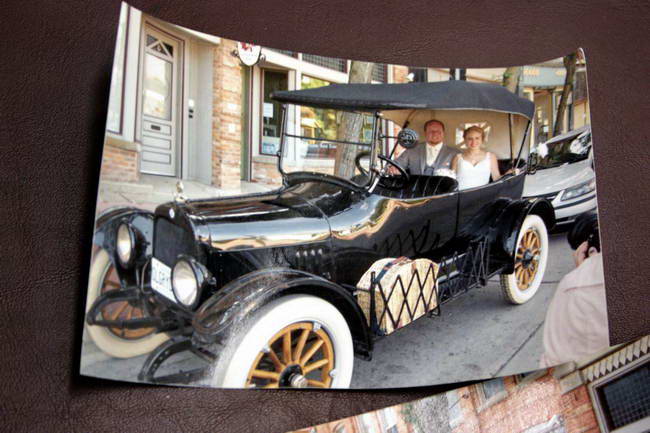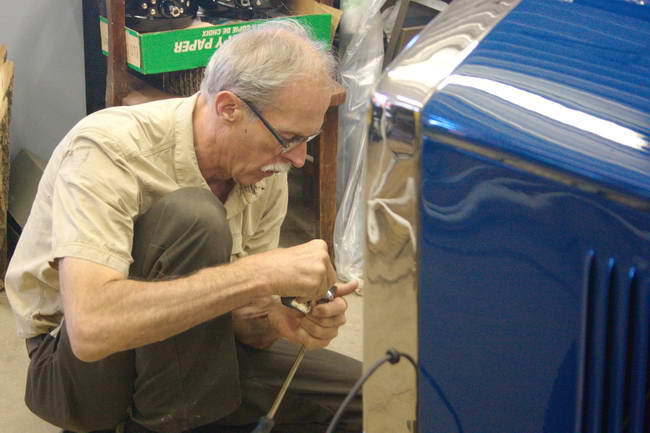Originally Built in Chatham, The Gray-Dort Lives on in Blenheim
Classic Coachworks is situated a few blocks off Blenheim, Ontario’s downtown main street. A quick look while passing by only reveals that, at least, this is the haunt of an avid automotive collector. Antique gas pumps frame the front of the building while scattered car parts form an automotive rock garden around the building’s verge. A rusty hulk from a bygone era happens to be sitting out front this day, awaiting its turn to be given new life. The large garage door is shut, preventing prying eyes from seeing what historic treasures may lie inside. This is a place where metal, wire, rubber, leather, wood, oil, and fire are brought together to bring life to automotive history. And, more than any other place, Classic Coachworks is a shrine to the Gray-Dort automobile.
The visionary within the walls of Classic Coachworks is Stan Uher. For over forty years he has been maintaining and restoring classic cars, but the Gray-Dort is his specialty. At the moment, he is sitting on the floor in front of an immaculate blue and black 1923 Gray-Dort as he prepares to install its front bumper. He sets down his tools, stands, and moves to a chair by his desk. He begins to talk about the business he has built, but the conversation quickly turns towards his passion, the Gray-Dort automobile, and its history. “I started restoring antique vehicles full-time in 1980. I was one of the first five guys hired at the RM restoration company [RM Classic Cars, Inc]…. That immersed me into the old car world. But the fact that the Gray-Dort was built in Chatham — it was just natural for me to lean towards that as a favorite.”
The Gray-Dort was produced in Chatham, Ontario from 1915 until 1923. Cars, in one form or another, were being manufactured as early as the late 1800s. Often impractical and dangerous at the outset, they evolved over the decades and became more useful, safer, and therefore common. The turning point for the fledgling auto industry occurred in 1908 when Henry Ford produced the Model T, which became the first car widely available and generally affordable to many people. During the early 1900s, manufacturers across the world jumped on the automobile bandwagon, and car companies came and went at a rapid pace. Some grew, others merged, and a few manage to survive to this day. The majority of them, however, went out of business for a number of reasons. Gray-Dort did not escape the fate of the majority but had a comparatively good run. By the end of production, the company had built around 26,000 cars for the Canadian Market.
Gray-Dort History is Local History
This local history is what provides the icing on the cake for Stan. “I’ve come to know all of the surviving relatives of the Gray Family. They are spread out all over Canada. I’ve really taken it steps further and created a registry of all the existing Gray-Dort cars and just completely immersed myself into the history and the heritage of the car and the family. Not only the car and the family, but the business. They were the biggest producer of horse-drawn vehicles in all of Canada before they started building cars. They made something like 270,000 horse drawn vehicles before they started building cars.” Stan mentions that a large part of the Gray family’s success was due to the reputation of quality they had created and that the company had built a dealership network across the country. When the product line shifted from carriages to cars, the Grays had a ready-made distribution network already in place that was backed by their trusted name.
In order to move into the automobile business, the Grays entered into a licensing deal with Dallas Dort and the Dort Motor Car Company based in Flint, Michigan. This allowed the Grays access to parts, drawings, and engineering support. The parts were shipped to Chatham, and the cars were assembled and sold from four large buildings all located in Chatham. At the start of production, the car was almost all American parts, but this would change over the years. Stan says, “Through the years the Gray family tried to get as much Canadian content as possible, so there are a few uniquely Canadian features to the Gray-Dort. …If you had a Dort and a Gray-Dort side by side and you took the badges off of both of them, even I would have a little bit of trouble figuring out which was the Dort and which was the Gray-Dort. Same chassis, same stampings, body stampings, same interior design, same engine.
“By 1920 it was 60% [Canadian parts]. In 1915,… it was almost all Flint supplied parts. They could have continued to have high American content, but we had lots of industry here that could make the same stuff and so the Grays utilized that network of manufacturers so that it would be more Canadian. People wanted to support uniquely Canadian businesses and so the Grays tried to do that by increasing the content of Canadian manufactured items that were used to build the car. There were tariffs in place back then, too. Shipping complete American cars would render them 25% more expensive. “
Like today, cars of that era came at all different price points and degrees of luxury. Where did the Gray-Dort fit in? Stan answers that question by pointing to the car he is currently restoring, a 1923 Model 25 Sport Touring. “About a third of the way up. This is definitely not the bottom and as the years went by, actually, both Dort and Gray-Dort became quite the car. At the end of production, they were probably closer to being halfway up the scale. When they finished, like this one here, boy– it rivals a lot of pretty nice cars of that 1923 vintage. And in every respect, whether it’s in engine, or details, dash, or appointments, it’s pretty neat.”
100 years later, there are not too many examples of those 26,000 Gray-Dort cars left in existence. Stan says there are, ”two that I know of in the states, and one in England and one in Austria. But of course, the bulk of them are here in Canada. When people ask me … I say ‘40 running or runnable cars.’ A lot of them have been sitting in museums for decades. They are likely runnable but they may take a little work to get them running.”
Barn finds and unlikely discoveries could always add to the total of runnable cars. As to the question of how many more of these Chatham-built cars could be put back on the road, Stan says, “I have a running registry of all the Gray-Dorts existing. And some of them aren’t very much of a car. So, there’s probably another 20 or 30 that could be made into cars but would be [a] massive, intense restoration. There’s forty runnable cars and there may be up to 40 other piles. Anything from restorable cars to piles of bones.
“Five of those piles of bones I have here. One of them for sure will be made into a car. I have a roadster project that is my retirement project. It will be the culmination of two or three different cars to make that one complete car. There are some out there we will never see on the road, ever,” said Stan. Once again indicating the Model 25, he goes on to relate that, “This one is one of the exceptions. This one was a pile of bones and then this doctor from Manitoba brought it up to me and now it’s just about done. It took the culmination of three different cars to make it a complete car.”
Great Restorations Take Commitment
Stan’s skill and passion have combined to make Classic Coachworks a labour of love. He is not a boastful man, but one can still sense his pride when he talks about how he came to restoring these old machines. Questioned about how he knew this was to be his vocation, that he could be exceptional in the field of car restoration, he replied, “A lot of the tasks I perform now, they come very easy. I came to that realization even while I was still at RM, that certain things just were kind of– that they were just easy and simple for me to perform and figure out. Even woodcarving. One of my last tasks at RM was a hand-carved funeral coach and I did all the wood carving myself. It came very easily to me. I guess I’m just lucky that way and that’s carried me through all these years.”
It’s not just mechanical know-how that has allowed Stan to bring these cars back to life. Problem-solving and reasoning skills play a major part as well. Stan asserts that it’s “not only the skills but the knowledge – to know what is correct as far as original details. And I’ve acquired that, of course, through the years. It’s more of a hands-on approach. Taking something apart, I have the ability to analyze, I suppose, and visualize how it was built at the factory and what the logical progression of assembly would be. Logic has carried me immensely through this business because mechanical things are all based on logic – and that’s how cars are built. That carries me through figuring out original details.”
A successful restoration also takes the right car owner. Stan states, “Lucky for me I have clients that want that high a quality of car. And ‘that high a quality of car’ usually means bringing the car to a state where it is exactly as it was brand new, in every form, whether it’s function or detail or finish or appearance or the right fasteners, the right wiring, the right construction. You know, every little detail — my clients want that to be exactly as it was brand new. And that’s as high as you can go in the restoration business – returning something back to the way it looked when it rolled off the assembly line. “
Not surprisingly, a few of the cars that Stan has restored can be seen around Chatham-Kent. “My first project here, in my newly opened shop in 1989, was a Gray-Dort Touring which ultimately ended up at the museum in Chatham. It is a part of their collection now.” He reveals that he gets to revisit that car on occasion, making sure that it can still run. “I did that, I think, last year. They were changing their exhibit and I hadn’t driven it in about 7 years, so it was a good opportunity for me to put fresh gas in it and take it out.” He even managed to take a few municipal employees for a short drive.
Operating the cars is important to their preservation if the goal is to keep them in runnable condition. “That’s the thing for these old cars; to run them. Unfortunately, when they sit in museums, things can dry up or go bad. So I did a little bit of work on it there last year then fired it up and went for [about] an hour drive around town. It probably would fire up with fresh gas now with very little effort. But that’s the key to keeping them running properly; to try to get them running as often as possible.”
Stan, unsurprisingly, has his own Gray-Dort, which sees the road fairly often. He says, “We get huge pleasure out of driving our 1915 Gray-Dort. We personally own the oldest Gray-Dort known to exist, with the very earliest serial number.” And he isn’t shy about sharing his love and knowledge of old cars with others. “Oh, it’s great! When I drive an old car, it’s easy to transport yourself back into that time period. When we stop and talk to people – when they realize it’s a Chatham built car – that’s even more exciting to talk about, and for people to know about.
“I’m doing a wedding of a young couple tomorrow afternoon with our Gray-Dort. And they were all excited about it, especially the fact that it was built in Chatham.” There will be an unexpected treat for them, too. Stan mentions, “ A little added thing, that giant mural on [The River Rock Social House]? Well, that car – that’s our car. Tomorrow, when I take this couple around, do the driving, we’re going to stop there and take pictures in front of my own car up on the mural. That will be kind of fun.”
As much as he prizes the Gray-Dort and its history, Stan will do restoration work on just about any vintage automobile. He says, “I specialize in pre-World War Two cars. The bulk of what I have done is cars of the 20s and ’30s. I have done a few post-war cars but not many. I like these better and I’ve come to understand them better.
“That’s a kind of dying breed, you know, of people that can understand cars of pre-World War Two vintage. I’m lucky that way, in that I continue to get cars from clients. That hulk out front is a ‘39 Packard funeral coach that came from a funeral home near Ottawa. [The owner] brought it here because he knows I specialize in the pre-war vehicles. It makes a better, easier restoration for them. Cheaper–because I know what I’m doing. And they get a quality car that they can jump in and drive anywhere. He’ll be able to jump in and drive that rig home to Ottawa if he wanted to when it gets done. Probably be a couple years, but that’s a big, big project.
“When I started my mechanics apprenticeship in 1975, right out of school. We were working on cars of the 50s and 60s. That was just the norm back then, mostly 60s. I still understand them now and can repair them all, so they all come easy. You start getting into computers, you’ve lost me! For one thing, you need to hook up to a computer to fix a computer-driven car, right? And I don’t have that means here. Anything prior to that is just kind of second nature to me now. I can do it all, fortunately,
All of this work is pretty much all Stan, too. “Everything gets done here by me, except for the plating -chrome and nickel plating- and the actual paint. I have a fellow that used to work for me that’s an ace painter that has his own business near Erieau. The spraying and the actual plating are the only two things that leave the shop. And major engine rebuildings. Other than that, all the mechanical stuff – I do it here. And all bodywork, metal fabrication, and the mechanical assembly, upholstery, convertible tops, all of that stuff, stays right here. As far as restorations go, I can only do one or two cars a year; one or two complete restorations a year.” And it’s not just full restorations that keep him busy. “But I do countless other short term jobs. Everything from appraisals to just maintenance things.”
What of the Future?
Even though work is steady, Stan has an eye on the next stage of his life. He’s looking forward to building his second Gray-Dort as a retirement project, and that retirement is on the horizon. His voice gets a little quieter as the subject turns to the next few years. I have twin daughters that pursued other directions… When I’m done, the business is done, and that’s that. But having said that, I will be here until they carry me out.
“I’m looking forward to being able to just kind of tinker away on my own projects, like that Gray-Dort roadster, and not have to worry about paying bills. That’s what I am working towards, and hopefully, it will come in the next two or three years.” But even in retirement, he will still be working on the cars he loves, just at a slower pace. Chatham-Kent has many car collectors and some of them currently often call on Stan. “There are several people that I take care of their collections … and I will continue to do that and will continue to keep them running…I look forward to doing that. It will be just fine.”
As the interview concludes, he gets up out of his chair and begins installing the front bumper of the Model 25. He is surrounded by memorabilia, parts, patterns, and plans. A 1939 Chevrolet awaits his attention off to one side. He is in his element and is at the top of his specialty. “Maybe I will have one full restoration on the go all the time, I suppose, but hopefully that will turn into my own restoration, you know? That’s kinda the plan, anyway. It’s a passion. I’m lucky to be able to make a living doing what’s passionate to me. I am fortunate that way.”
Feature image courtesy of Stan Uher and Tom Slager / Content Images courtesy of Tom Slager
Interview conducted September 17, 2020












We found a 1918 Gray Dort touring model a year ago in Manitoba,with 16000 original miles.It is now running and partially restored.
I was born and grew up in Chatham,and my father once told me he worked at Gray Dort when he came to Canada, so it has a special meaning.
How exciting Carl. Can you send me pictures?
At one time my great uncle Noble Hurdle and his first cousin Clarence Hurdle had a Gray-Dort dealership in Newbury, Ontario. I have a photograph someplace that shows them standing out front of the building. Nice to see a piece of local history restored to running state.
evelyn hill9 sept.20220 18.21 australia
i have the remains of several dort , 2 with lycoming 4 cylinder motor 2 with hershall spilman 4 cylinder motor model no C59 as far as i know there are a few dorts in australia in south australia they were used to inspect the rail line also several book of instructions dort motor cars covers modelsroadster,8coupe,11touring,11sedan11tsedanet + 14 roadster,19touring,14coupec,14t coupe,19sedan,19t sedan. 20 roadster,25 touring,20ch harvard coupe,20t yale coupe,25sh harvard sedan 25t yale sedan, 20k sport roadster, 25k sport touring 1922 models 14.14c,14t,19, 19s,19t, 49a 52a . gray dort 6m roadster 11c coupe, 11touring, 11s sedan , 11t sedanet
yale sedan,20k sport roadster ,25k sport touring,+ 49a ,52a, and a later one with a the first 4 pages missing with the hershal spilman motor and a
view of the rolling chassis with a lycoming motor and a gray dort model 11
evelyn hill9 sept.20220 18.21 australia
i have the remains of several dort , 2 with lycoming 4 cylinder motor 2 with hershall spilman 4 cylinder motor model no C59 as far as i know there are a few dorts in australia in south australia they were used to inspect the rail line also several book of instructions dort motor cars covers modelsroadster,8coupe,11touring,11sedan11tsedanet + 14 roadster,19touring,14coupec,14t coupe,19sedan,19t sedan. 20 roadster,25 touring,20ch harvard coupe,20t yale coupe,25sh harvard sedan 25t yale sedan, 20k sport roadster, 25k sport touring 1922 models 14.14c,14t,19, 19s,19t, 49a 52a . gray dort 6m roadster 11c coupe, 11touring, 11s sedan , 11t sedanet and a later one with a the first 4 pages missing with the hershal spilman motor and a view of the rolling chassis with a lycoming motor